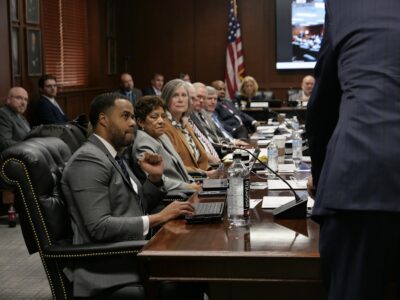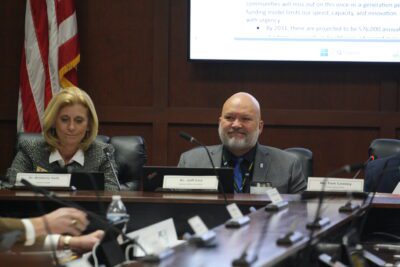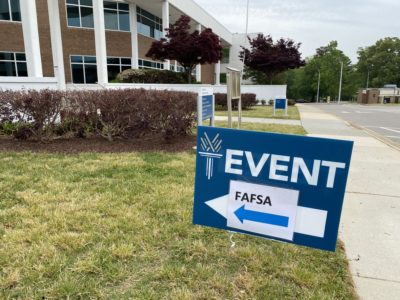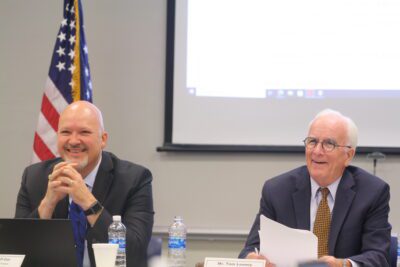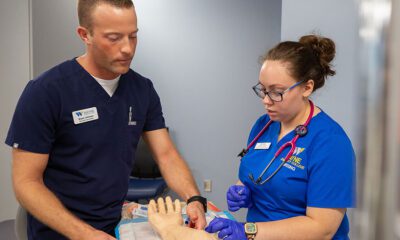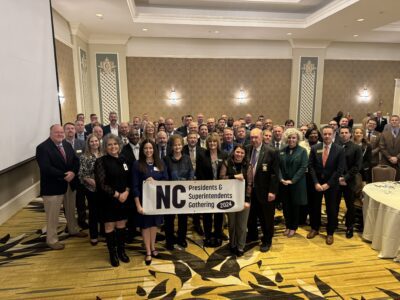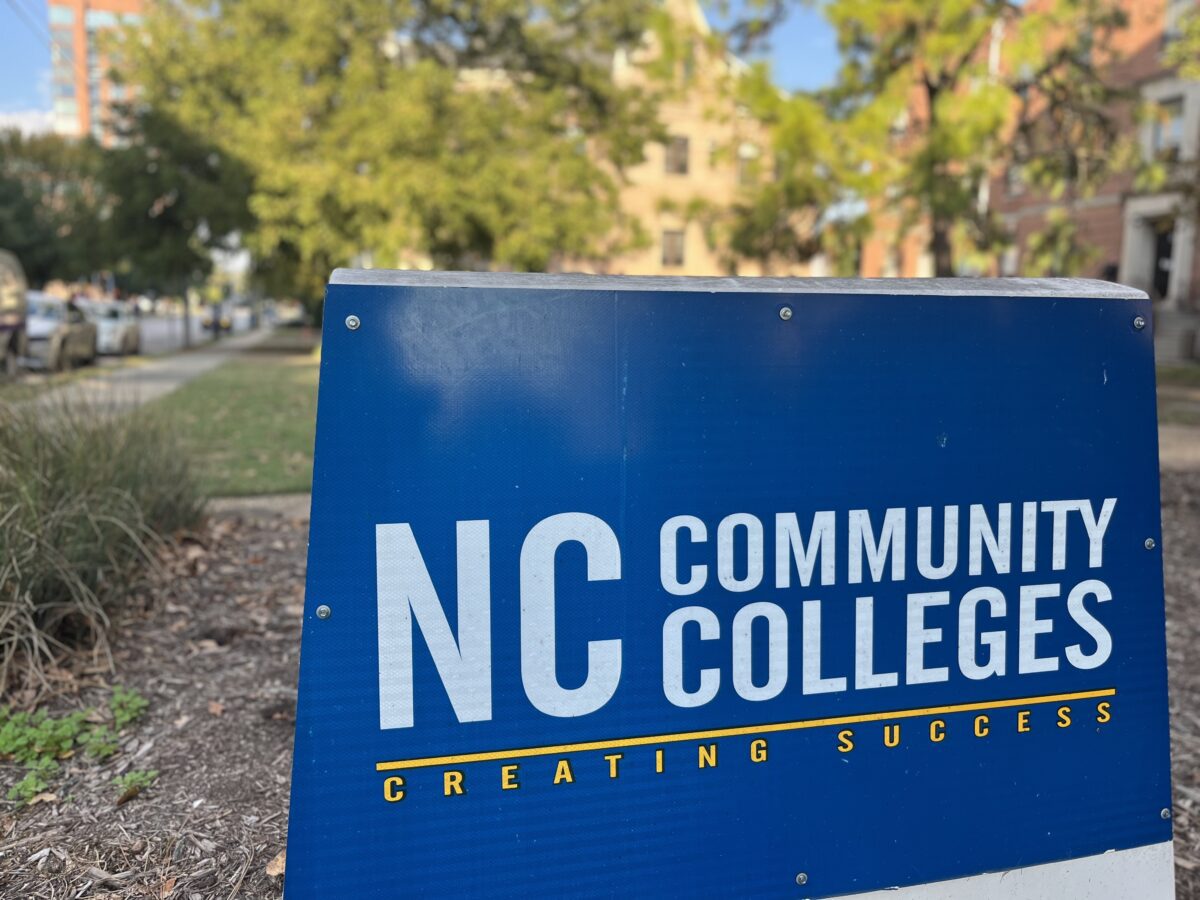

|
|
What will the coming months — and a new legislative session — bring for the North Carolina Community College System (NCCCS)?
In recent years, the issues influencing the system have been remarkably consistent.
Would the system turn around enrollment declines? Would North Carolina’s commitment to early colleges and dual enrollment remain strong? Would the General Assembly invest in faculty and staff salaries?
This year seems different.
North Carolina has been named the best state to do business for two years in a row. Our state is set to produce semiconductors, electric vehicles, batteries for electric vehicles, supersonic jets, and other cutting-edge products. Apple and Google are significantly expanding their footprints in the Triangle while their servers are housed in data centers spread across the state.
The state has had a record number of economic development announcements, promising employers that they will find a well-trained workforce. Community colleges remain essential to meet this commitment given their ability to offer apprenticeships, customized training, stackable credentials, and more.
This year will also bring the legislative short session in the spring and elections in the fall, both of which have the potential to significantly impact the community college system.
Against this backdrop, N.C. community colleges are asking for more resources to meet workforce demands, advocating for a new state funding model, looking to increase enrollment in the face of policy changes and a bumpy FAFSA rollout, and implementing governance changes from last year’s budget.
A new funding model emerges: Propel NC
This fall, the community college system developed and approved Propel NC, a proposal to align their funding model with our state’s workforce objectives.
Propel NC is not just a refresh of the funding model. It places the North Carolina system squarely in the middle of a national conversation around reimagining the connections between employers and community colleges.
The current funding model allocates funding to colleges based on the number of full-time equivalency (FTE) students they enroll in their programs. Courses are grouped into tiers, and some tiers receive more funding per FTE than others.
Propel NC would redesign the formula to align with workforce needs. This move would shift from funding based on tiers to funding based on “workforce sectors” that align with labor market needs. Importantly, under Propel NC, curriculum and short-term workforce courses (continuing education courses) would be placed in the same workforce sector and receive the same funding per FTE. The current sectors largely focus on health care, technology, and other skilled trades, and the model is designed to periodically shift sector funding to align with evolving workforce needs.
Other components of Propel NC include:
- Increasing the base allocation for instructional and academic support funds by 5.8%;
- Restructuring the enrollment increase reserve; and
- Allowing excess tuition receipts to return to the college which generated them on years when the system as a whole generates excess receipts.
Both the North Carolina Association of Community College Presidents and the State Board of Community Colleges have unanimously approved the new model.
“Propel NC is a dynamic and responsive change that allows us to meet the evolving needs of employers and get the next generation of workers ready for high-demand, good-paying jobs,” State Board of Community Colleges chair Tom Looney said in a recent system release. “We need to take action now to ensure that our colleges continue to lead in delivering a skilled workforce essential for North Carolina’s ongoing economic development.”
Ultimately, implementing Propel NC requires legislative action, so the system’s advocacy for the new funding model will be one of the largest issues in the year ahead. The plan includes a $93 million recurring ask to lawmakers, according to a NCCCS document outlining the model.
The argument the system office and colleges will be making to legislators this spring is that the success of our community colleges will underpin our state’s ability to fulfill its promise of a readily available skilled workforce.
In the weeks ahead, colleges will host legislators to underscore the critical role they play for local communities and call on their business partners to make the case for the model. At the February State Board meeting, Looney said more than 100 businesses have endorsed the plan so far.
Propel NC is part of a national conversation around funding
The work on Propel NC is consistent with conversations unfolding across the community college landscape nationally around the role of community colleges as workforce and economic development catalysts.
Achieving the Dream CEO Karen Stout recently wrote an article outlining why colleges and employers must work together to improve opportunities for employees:
“The big question today is how community colleges can help both our students and the communities we serve cut down that opportunity gap. I have argued that if community colleges are going to remain relevant, we must no longer see our role as lifelong learning institutions but as lifelong career-matching institutions — catalysts for building equitable, prosperous, and vibrant communities that connect workers to lucrative career pathways to high-wage jobs and the middle class. …
Making this change requires that community colleges build an entirely new relationship with employers across industry sectors: One that is built on the idea that business and postsecondary education are equal partners in preparing people for careers and that each has an equal responsibility to initiate partnerships.”
Other states, including Pennsylvania, are examining both governance and funding model shifts that would align more closely with workforce outcomes.
Enrollment trends
EdNC will be monitoring enrollment trends across the system in 2024. The good news is that enrollment was up for fall 2023 both in North Carolina and nationally.
At the February State Board of Community Colleges meeting, NCCCS reported a more than 5% increase in Full-Time Equivalent (FTE) student enrollment (105,174 from 99,880) in fall 2023.
“I’ve got some good news as far as enrollment goes. We’re up pretty good,” said Dr. Bill Schneider, NCCCS vice president of system effectiveness. “We still have some work to do as far as going back to where we were before Covid… but we’re almost back to where we were.”
Community colleges nationwide saw a 2.6% increase in enrollment, according to data from the National Student Clearinghouse Research Center. This represented the largest enrollment increase across the postsecondary landscape nationally.
Several community colleges are reporting continued enrollment growth this spring, but several factors could impact that growth over the next year.
The impacts of the new FAFSA and potential Pell Grant changes
The Free Application for Federal Student Aid (FAFSA) has gone through a redesign with a goal of simplifying the process for students and families. A simplified process should be a positive outcome, but the rollout of the new FAFSA has proven rocky.
The U.S. Department of Education announced a delay in the distribution of FAFSA data to colleges, now expected to be in March or possibly later, due to a necessary adjustment in the formula to account for inflation. This most recent update comes after the FAFSA’s opening was pushed back by three months from its usual October timeline. Colleges rely on this critical data to determine students’ eligibility and distribute financial aid.
It also remains to be seen whether Congress will pass legislation to make Pell Grant dollars available for students enrolled in short-term workforce development programs. Passage of such legislation could open the door for enrollment growth for colleges, as it would give them an opportunity to reach out to students who might otherwise believe such workforce programs are out of reach for them due to cost. The U.S. House of Representatives was scheduled to take up the issue last week but pulled it back from consideration at the last minute.
Policy changes impacting dual enrollment
The rate of dual enrollment is one indicator of financial health for community colleges. For rural colleges in particular, dual enrollment has been a key driver of enrollment.
The most recent budget required the State Board of Education to create a three-year graduation track for high school students that will go into effect in the 2024-25 school year. While K-12 leaders wait for a technical correction to allow local school districts to require a longer track, community college leaders are waiting to see how this policy will impact them. Read more about this policy here.
Last year’s budget also significantly increased funding for North Carolina’s Opportunity Scholarship program, which provides state-funded vouchers for students to attend private schools. More students opting to use Opportunity Scholarships to attend private schools could also have an impact on dual enrollment participation.
Making sure college is worth it for traditional-aged students
North Carolina community colleges have seen success engaging and enrolling adult learners, but 18-24 year olds remain an essential audience for colleges.
Caldwell Community College president Dr. Mark Poarch recently shared that in a survey of local high school seniors, more than 40% said they intend to go to community college. However, the number that actually showed up on his campus is less than 20%. Poarch and his colleagues are developing new strategies to try and reduce what has traditionally been dubbed “summer melt.”
Reducing summer melt must include successfully countering the “college isn’t worth it” messaging that has gained traction in recent years, Poarch said.
As reported in Newsweek, #NotGoingtoCollege and variations of that hashtag have received more than 30 million views on TikTok.
“More than one in four high school seniors from the class of 2022 say they’ve ‘changed their post-secondary-school plans since the start of the pandemic,’ according to a survey by the nonprofit YouthTruth, with less than half now planning to attend a four-year college,” reports Newsweek.
In order to counter this messaging, colleges will need to consider what message they are sending to prospective students. The “Better Skills, Better Jobs” framework offered up as part of N.C. Reconnect seems to resonate, according to the colleges involved, and similar messaging may offer an opportunity to reach those who doubt the value of college. Poarch said his college believes the campaign offers the type of outcome-focused messaging that truly resonates with their community.
And, of course, it is important to remember the students already on campus. Retention is critical for colleges moving forward, and several are reconsidering their strategies around retention. Surry Community College, for example, has launched a campus-wide focus on retention that occupies “the overwhelming majority of our efforts and the discussions we hold across campus,” according to president David Shockley.
Other factors impacting community colleges this year and beyond
Faculty and staff pay
Faculty and staff pay remains a factor, impacting recruitment and retention across various positions at our community colleges. Months-long vacancy postings highlight the severity of this issue.
The General Assembly has increased pay in recent years, particularly in high-demand fields such as nursing, but colleges still find themselves at a disadvantage when it comes to the financial packages they can offer high-demand faculty and staff.
Governance
Last year’s budget included several governance changes for both the State Board of Community Colleges and local boards of trustees. As EdNC’s Hannah McClellan reported:
- The State Board’s election of a system president is now subject to confirmation by the General Assembly. At least three final candidates should be submitted to the full Board, and the candidate who receives a majority of votes of the entire Board should be elected. The person elected by the Board will serve as interim-President until the General Assembly adopts a joint resolution confirming the selection.
- The Board will consist of 19 members, including the president of the North Carolina Comprehensive College Student Government Association (N4CSGA) as an ex officio member. The General Assembly will elect the other 18 members of the Board “at large to a term of four years beginning July 1 of an odd-numbered year and until a successor is elected and qualified.” Under the budget, the governor no longer has any appointments to the Board.
- Each community college has a local board of trustees. The budget changed the selection process for these local boards. Eight trustees will be appointed by the General Assembly — two members annually. Four trustees will be elected by the board of commissioners of the county in which the main campus of the college is located. One of those four trustees can be a county commissioner. In addition, each board of commissioners of any other county “in the administrative area that provides plant funds to the institution shall elect two additional trustees to the board,” the budget says, one of whom may also be a county commissioner.
Leadership transitions
The NCCCS continues to experience leadership transition. Dr. Jeff Cox became the new system president in June 2023 after several years of leadership turnover.
The State Board set clear performance goals for Cox, including leading the system’s strategic plan initiatives, strengthening the system office’s structure and culture, engaging crucial constituencies, and facilitating development of a statewide marketing initiative.
When EdNC sat down with Cox to discuss his agenda, he said he would advocate for updating the system’s funding formula to enable community colleges to be more innovative and proactive in their programs.
Legislators, state leaders, and community college stakeholders alike want the NCCCS to “be the most innovative kind of forward-thinking community college system in the country,” Cox shared.
“If we’re going to do that, and be ready to be agile and work at the speed of business and meet business and industry where they are and be able to launch programs quickly and effectively and efficiently, that takes resources,” he said. “We need to think about that in the funding formula, to think about to what extent we need additional funds to start up new programs.”
The unanimous endorsement of Propel NC by both the presidents association and the State Board is a sign of his early success at working alongside presidents from across the system to build consensus.
In addition to system leadership transition, individual colleges continue to see leadership turnover. In the last four years, 29 of our 58 college presidents were appointed to their current position, and there are four active presidential searches.
Alamance Community College president Algie Gatewood, Martin Community College president Wesley Beddard, and Pitt Community College president Lawrence Rouse are among those who have either recently retired or announced their retirement. All three had decades of experience in the NCCCS.
The Belk Center for Community College Leadership and Research, among others, have worked hard to build out a leadership pipeline for community college presidents to help support the system and the colleges during this time of transition.
Collaboration
The system’s strategic plan calls for greater regional collaboration throughout North Carolina’s community colleges. Legislators have also made it clear that they hope to see greater collaboration amongst our colleges. The devil will be in the details, as the old saying goes.
Questions include: How can the state financially incentivize collaboration between colleges? What role will business and industry play moving forward? How can colleges tighten their relationships with employers with statewide or regional reach?
Examples of promising collaborations are emerging, such as AdvanceNC in central North Carolina, the biopharma partnership between Durham Tech and Wake Tech, and the work of several western community colleges to support Pratt Whitney’s expansion.
Take a look at this outline for regional collaborations reviewed by the State Board of Community Colleges for models the system has lifted up.
A critical year ahead
2024 is an election year with every statewide office up for grabs, as well as the entirety of the state legislature.
Lt. Governor Mark Robinson is running for governor in the Republican primary. As a member of the State Board of Community Colleges, Robinson recently endorsed Propel NC at a State Board meeting:
“Moving from tiers-based to labor-market driven, I would suppose that would give us a lot more flexibility, so I think that’s very good,” he said. “Community colleges are going to be essential (to the economy)… so I’m glad to see the work that’s going on.”
State Treasurer Dale Folwell is both one of his opponents in the Republican primary and a fellow member of the State Board. Folwell also supports Propel NC.
“I support President Cox and the Board’s efforts to ‘propel’ the NC Community College system forward,” Folwell shared with EdNC. “I have been concerned for over a decade about the disparate ways that our three major systems are funded. Some are funded on average daily membership, some on population in arrears, and some based on growth that is difficult to measure. At the end of the day, it comes down to having a system that puts the joy of achievement and upward mobility into our citizenry.”
Robinson and Folwell are also running against attorney Bill Graham on March 5.
Attorney General Josh Stein is competing for the Democratic nomination for governor. He has toured a number of community colleges during his campaign so far. Stein is running against North Carolina Supreme Court Justice Mike Morgan, Tryon Mayor Pro Tempore Chrelle Booker, attorney Marcus Williams, and Edgecombe County Sheriff’s Office reserve deputy Gary Foxx.
This is a short session year for the General Assembly where the legislature will take up adjustments to the base budget they approved last year.
The system office and the 58 college presidents will make the case for a $93 million recurring investment in Propel NC. Presidents have indicated they expect this could make fully funding Propel NC a multi-year campaign.
Additional budget requests will come against the backdrop of the state’s projected revenue. Dan Gerlach’s analysis of revenue following recent tax cuts provides helpful context.
EdNC will be keeping up with all of these issues and more. Please join our texting line and subscribe to Awake58 if you do not already do so.
We will see you out on the road as EdNC continues to travel across the state to meet college leaders, faculty, staff, and students on the campuses of the 58.
Behind the Story
Nation Hahn used the following prompt with Claude AI to copy edit the first draft of this article prior to it being submitted to EdNC’s editorial process: “Please review the following text for grammar, spelling, and punctuation errors. Provide suggestions for improvement while maintaining the original tone, wording, and style. I would also like to ensure that my writing adheres to the AP style guide. Please review and provide feedback.” The copy edits suggested by AI did not include revisions to wording of the draft. Claude AI is owned by Anthropic.



